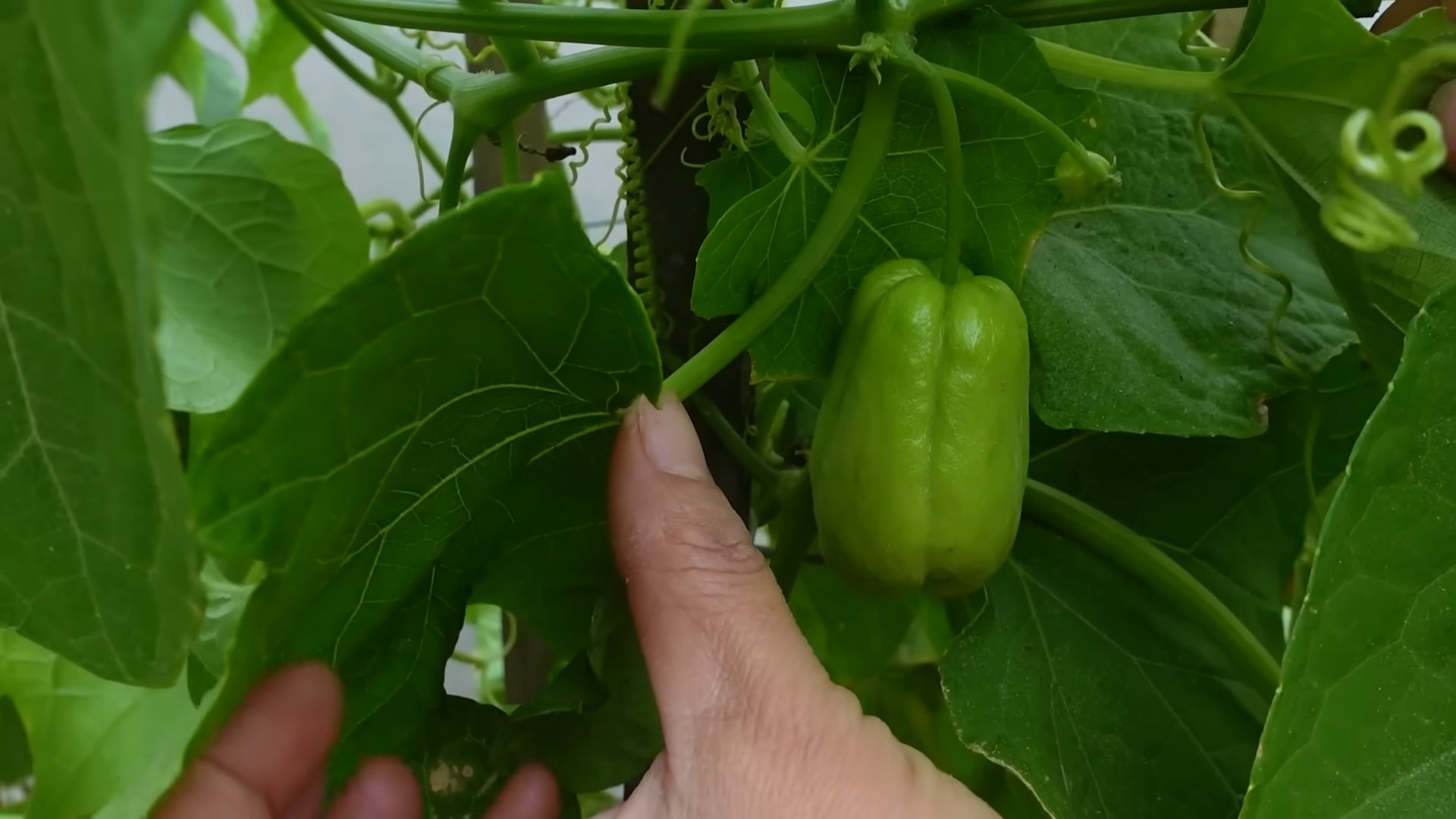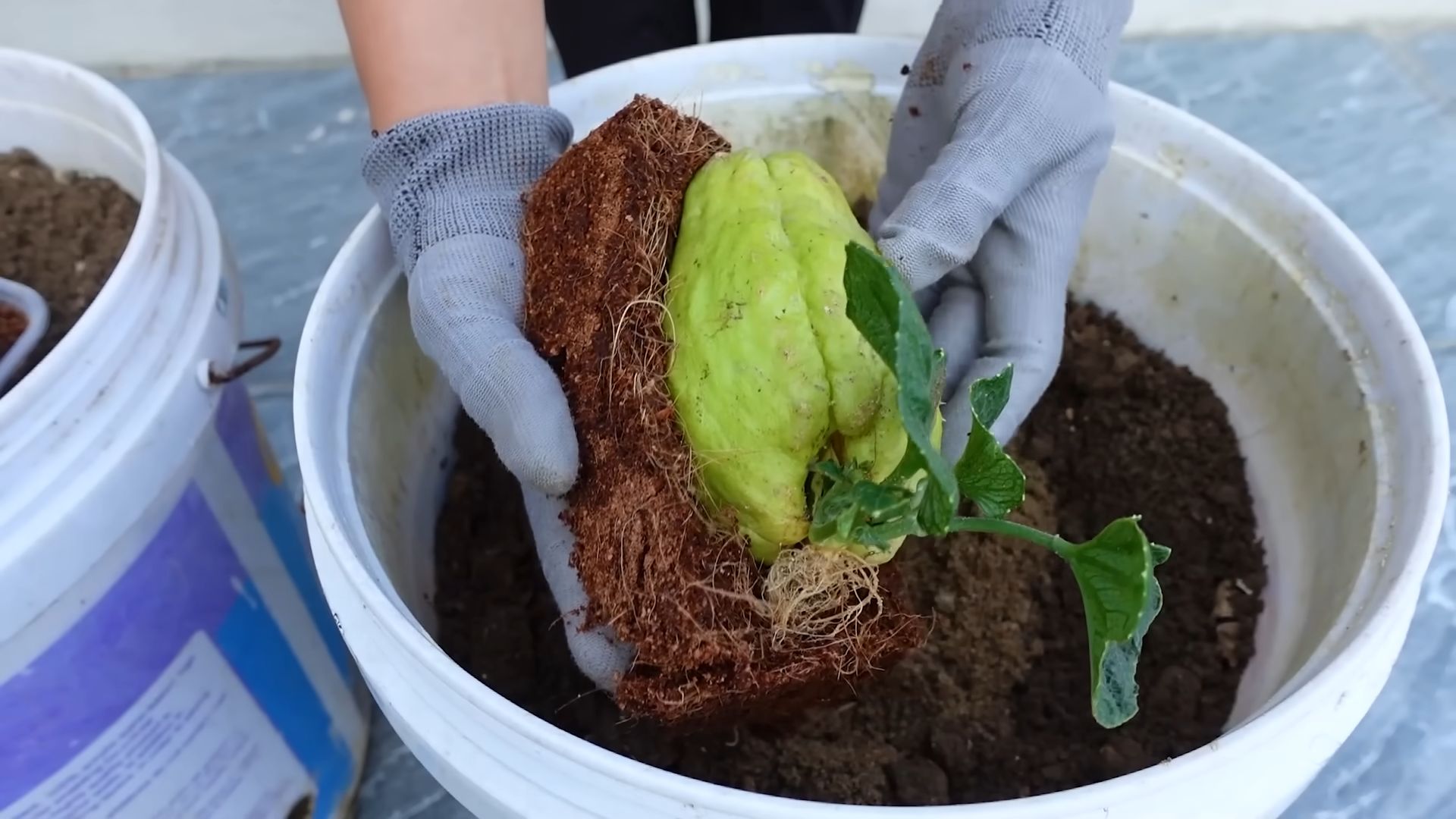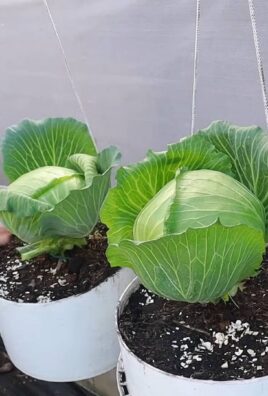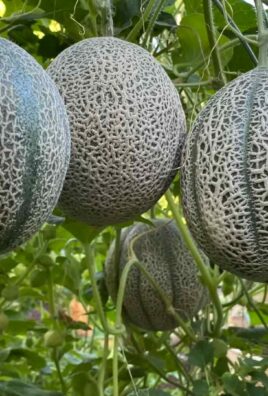Growing Chayote at Home can seem like a daunting task, but trust me, it’s more rewarding than you might think! Have you ever imagined harvesting your own delicious, pear-shaped squash right from your backyard? This isn’t just a dream; it’s an achievable reality with a few simple tricks and a little DIY spirit. I’m here to guide you through the process, making it easier than ever to enjoy fresh, homegrown chayote.
Chayote, also known as vegetable pear or mirliton, has a rich history, particularly in Mesoamerica, where it has been cultivated for centuries. It was a staple food for the Aztecs and Mayans, and its versatility has allowed it to spread across the globe. Today, it’s enjoyed in various cuisines, from stir-fries to soups, offering a mild, slightly sweet flavor that complements many dishes.
But why bother growing chayote at home? Well, for starters, it’s incredibly satisfying to nurture a plant from seed (or in this case, the whole fruit!) to harvest. Plus, you’ll have access to fresh, organic produce without the hefty price tag or the uncertainty of store-bought options. In this DIY guide, I’ll share my favorite tips and tricks to ensure your chayote vine thrives, providing you with an abundance of delicious squash. Get ready to roll up your sleeves and embark on a rewarding gardening adventure!

Growing Chayote at Home: A Complete DIY Guide
Hey there, fellow gardening enthusiasts! Ever thought about growing your own chayote squash? It’s easier than you might think, and the rewards are delicious! Chayote, also known as vegetable pear or mirliton, is a versatile and prolific vine that can add a unique touch to your garden and your dinner table. I’ve been growing chayote for a few years now, and I’m excited to share my experience and guide you through the process.
Choosing Your Chayote
First things first, you need a chayote fruit to start with. This isn’t like planting seeds; you plant the whole fruit!
* Look for a mature fruit: You want a chayote that’s plump, firm, and free from blemishes. It should be starting to sprout – you’ll see small roots emerging from the bottom. This is a good sign that it’s ready to plant. If you can’t find one already sprouting, don’t worry! I’ll tell you how to encourage sprouting later.
* Source matters: Ideally, get your chayote from a local farmer’s market or a friend who grows it. This ensures it’s adapted to your climate. If you buy it from a grocery store, choose one that looks fresh and healthy.
* Variety: There are different varieties of chayote, ranging in color from light green to dark green, and some even have spines. The taste is generally the same, so choose based on your preference.
Sprouting Your Chayote (If Necessary)
If your chayote isn’t already sprouting, don’t panic! Here’s how to get those roots going:
1. Prepare a damp paper towel: Moisten a paper towel and wring out any excess water. It should be damp, not soaking wet.
2. Wrap the chayote: Wrap the bottom half of the chayote (the end where the roots will emerge) in the damp paper towel.
3. Place in a plastic bag: Put the wrapped chayote in a plastic bag, but don’t seal it completely. You want some air circulation to prevent mold.
4. Store in a warm, dark place: Place the bag in a warm, dark location, like a cupboard or pantry.
5. Check regularly: Check the chayote every few days to ensure the paper towel stays moist. If it dries out, re-moisten it.
6. Wait for sprouting: It can take anywhere from a week to a month for the chayote to sprout. Be patient! Once you see roots emerging, it’s ready to plant.
Preparing the Planting Site
Chayote vines are vigorous growers, so they need plenty of space and a strong support system.
* Sunlight: Chayote thrives in full sun (at least 6-8 hours of direct sunlight per day).
* Soil: Well-drained soil is crucial. Chayote doesn’t like to sit in soggy soil. Amend your soil with compost or other organic matter to improve drainage and fertility.
* Support: This is super important! Chayote vines can grow up to 30-40 feet long, so they need a sturdy trellis, fence, or arbor to climb on. I use a heavy-duty metal trellis that’s about 8 feet tall and 6 feet wide. You can also train it to grow on a sturdy fence.
* Space: Give your chayote vine plenty of room to spread out. Plant it at least 10-15 feet away from other plants or structures.
Planting Your Chayote
Now for the fun part – getting that chayote in the ground!
1. Dig a hole: Dig a hole that’s about twice the size of the chayote fruit.
2. Amend the soil: Mix some compost or other organic matter into the soil you removed from the hole.
3. Position the chayote: Place the chayote in the hole with the sprouted end (where the roots are) facing down. Leave the top part of the fruit exposed.
4. Backfill the hole: Gently backfill the hole with the amended soil, being careful not to damage the roots.
5. Water thoroughly: Water the newly planted chayote thoroughly to settle the soil.
6. Mulch: Add a layer of mulch around the base of the plant to help retain moisture and suppress weeds. I like to use straw or wood chips.
Caring for Your Chayote Vine
Once your chayote is planted, it’s time to provide it with the care it needs to thrive.
* Watering: Water regularly, especially during dry periods. Chayote needs consistent moisture to produce fruit. Aim for deep watering, allowing the soil to dry out slightly between waterings.
* Fertilizing: Feed your chayote vine with a balanced fertilizer every few weeks during the growing season. I use a liquid fertilizer diluted to half strength. You can also amend the soil with compost regularly.
* Pruning: Pruning isn’t essential, but it can help to control the size of the vine and improve air circulation. Remove any dead or damaged vines. You can also prune back the vine after it fruits to encourage new growth.
* Pest and disease control: Chayote is generally pest and disease resistant, but keep an eye out for common garden pests like aphids and squash bugs. If you spot any pests, treat them with an appropriate insecticide or insecti
Hey there, fellow gardening enthusiasts! Ever thought about growing your own chayote squash? It’s easier than you might think, and the rewards are delicious! Chayote, also known as vegetable pear or mirliton, is a versatile and prolific vine that can add a unique touch to your garden and your dinner table. I’ve been growing chayote for a few years now, and I’m excited to share my experience and guide you through the process.
Choosing Your Chayote
First things first, you need a chayote fruit to start with. This isn’t like planting seeds; you plant the whole fruit!
* Look for a mature fruit: You want a chayote that’s plump, firm, and free from blemishes. It should be starting to sprout – you’ll see small roots emerging from the bottom. This is a good sign that it’s ready to plant. If you can’t find one already sprouting, don’t worry! I’ll tell you how to encourage sprouting later.
* Source matters: Ideally, get your chayote from a local farmer’s market or a friend who grows it. This ensures it’s adapted to your climate. If you buy it from a grocery store, choose one that looks fresh and healthy.
* Variety: There are different varieties of chayote, ranging in color from light green to dark green, and some even have spines. The taste is generally the same, so choose based on your preference.
Sprouting Your Chayote (If Necessary)
If your chayote isn’t already sprouting, don’t panic! Here’s how to get those roots going:
1. Prepare a damp paper towel: Moisten a paper towel and wring out any excess water. It should be damp, not soaking wet.
2. Wrap the chayote: Wrap the bottom half of the chayote (the end where the roots will emerge) in the damp paper towel.
3. Place in a plastic bag: Put the wrapped chayote in a plastic bag, but don’t seal it completely. You want some air circulation to prevent mold.
4. Store in a warm, dark place: Place the bag in a warm, dark location, like a cupboard or pantry.
5. Check regularly: Check the chayote every few days to ensure the paper towel stays moist. If it dries out, re-moisten it.
6. Wait for sprouting: It can take anywhere from a week to a month for the chayote to sprout. Be patient! Once you see roots emerging, it’s ready to plant.
Preparing the Planting Site
Chayote vines are vigorous growers, so they need plenty of space and a strong support system.
* Sunlight: Chayote thrives in full sun (at least 6-8 hours of direct sunlight per day).
* Soil: Well-drained soil is crucial. Chayote doesn’t like to sit in soggy soil. Amend your soil with compost or other organic matter to improve drainage and fertility.
* Support: This is super important! Chayote vines can grow up to 30-40 feet long, so they need a sturdy trellis, fence, or arbor to climb on. I use a heavy-duty metal trellis that’s about 8 feet tall and 6 feet wide. You can also train it to grow on a sturdy fence.
* Space: Give your chayote vine plenty of room to spread out. Plant it at least 10-15 feet away from other plants or structures.
Planting Your Chayote
Now for the fun part – getting that chayote in the ground!
1. Dig a hole: Dig a hole that’s about twice the size of the chayote fruit.
2. Amend the soil: Mix some compost or other organic matter into the soil you removed from the hole.
3. Position the chayote: Place the chayote in the hole with the sprouted end (where the roots are) facing down. Leave the top part of the fruit exposed.
4. Backfill the hole: Gently backfill the hole with the amended soil, being careful not to damage the roots.
5. Water thoroughly: Water the newly planted chayote thoroughly to settle the soil.
6. Mulch: Add a layer of mulch around the base of the plant to help retain moisture and suppress weeds. I like to use straw or wood chips.
Caring for Your Chayote Vine
Once your chayote is planted, it’s time to provide it with the care it needs to thrive.
* Watering: Water regularly, especially during dry periods. Chayote needs consistent moisture to produce fruit. Aim for deep watering, allowing the soil to dry out slightly between waterings.
* Fertilizing: Feed your chayote vine with a balanced fertilizer every few weeks during the growing season. I use a liquid fertilizer diluted to half strength. You can also amend the soil with compost regularly.
* Pruning: Pruning isn’t essential, but it can help to control the size of the vine and improve air circulation. Remove any dead or damaged vines. You can also prune back the vine after it fruits to encourage new growth.
* Pest and disease control: Chayote is generally pest and disease resistant, but keep an eye out for common garden pests like aphids and squash bugs. If you spot any pests, treat them with an appropriate insecticide or insecticidal soap. Good air circulation helps prevent fungal diseases.
* Training the vine: As the vine grows, train it to climb the trellis or fence. Gently guide the tendrils to attach to the support structure.
Harvesting Your Chayote
The best part of growing chayote is, of course, harvesting the fruits!
* Timing: Chayote fruits are typically ready to harvest in the fall, about 3-4 months after planting.
* Signs of ripeness: The fruits should be firm and smooth, with a light green color. They should be about 4-6 inches long.
* Harvesting: Use a sharp knife or pruners to cut the fruit from the vine, leaving a short stem attached.
* Storage: Chayote can be stored in the refrigerator for several weeks.
Using Your Chayote
Chayote is incredibly versatile in the kitchen. You can use it in a variety of dishes, both savory and sweet.
* Raw: Chayote can be eaten raw in salads or slaws. It has a mild, slightly sweet flavor.
* Cooked: Chayote can be boiled, steamed, baked, fried, or grilled. It takes on the flavor of whatever you cook it with.
* Soups and stews: Chayote is a great addition to soups and stews. It adds a subtle sweetness and a pleasant texture.
* Stir-fries: Chayote works well in stir-fries. It cooks quickly and absorbs the flavors of the other ingredients.
* Pickles: Chayote can be pickled.
* Desserts: Believe it or not, chayote can even be used in desserts! It can be grated and added to cakes, muffins, or pies.
Troubleshooting
Even with the best care, you might encounter some challenges when growing chayote. Here are a few common problems and how to address them:
* No fruit: If your chayote vine is growing well but not producing fruit, it could be due to a lack of pollination. Chayote is pollinated by insects, so make sure there are plenty of pollinators in your garden. You can also try hand-pollinating the flowers.
* Yellowing leaves: Yellowing leaves can be a sign of overwatering or nutrient deficiency. Check the soil moisture and adjust your watering schedule accordingly. Fertilize the vine with a balanced fertilizer.
* Pest infestations: Keep an eye out for common garden pests like aphids and squash bugs. Treat them with an appropriate insecticide or insecticidal soap.
* Disease: Good air circulation helps prevent fungal diseases. If you notice any signs of disease, remove the affected leaves and treat the plant with a fungicide.
Propagating Chayote
You can propagate chayote by planting the whole fruit, as described above. This is the easiest and most common method. You can also propagate chayote from cuttings, but it’s more challenging.
Why Grow Chayote?
Growing chayote is a rewarding experience for several reasons:
* It’s easy: Chayote is relatively easy to grow, even for beginner gardeners.
* It’s prolific: A single chayote vine can produce dozens of fruits.
* It’s versatile: Chayote can be used in a variety of dishes.
* It’s nutritious: Chayote is a good source of vitamins, minerals, and

Conclusion
So, there you have it! Growing chayote at home is not only achievable, but it’s also a rewarding experience that brings fresh, delicious produce right to your table. We’ve walked you through the process, from selecting your chayote fruit to nurturing the vine and harvesting your bounty. But why is this DIY trick a must-try?
Firstly, consider the unparalleled freshness. Store-bought chayote, while readily available in some regions, simply can’t compare to the vibrant flavor and crisp texture of a homegrown fruit. You control the growing conditions, ensuring that your chayote is free from unwanted pesticides and herbicides. You’re also reducing your carbon footprint by eliminating the transportation involved in getting produce from farm to store.
Secondly, growing chayote is a fantastic way to connect with nature and learn about the life cycle of plants. It’s a hands-on activity that can be enjoyed by the whole family, teaching valuable lessons about sustainability and food production. Plus, the sheer abundance of chayote that a single vine can produce is truly remarkable. You’ll have more than enough to share with friends, neighbors, and family.
Thirdly, let’s talk about the versatility of chayote. This unassuming fruit is a culinary chameleon, adapting beautifully to a wide range of dishes. From stir-fries and salads to soups and stews, chayote adds a subtle sweetness and satisfying crunch. You can even pickle it, bake it into pies, or use it as a low-carb alternative to potatoes. The possibilities are endless!
Now, for some suggestions and variations to elevate your chayote-growing game:
* Experiment with different growing methods: While we’ve focused on growing chayote from the whole fruit, you can also try propagating it from cuttings. This method can be faster and more reliable, especially if you have access to a mature vine.
* Consider companion planting: Planting certain herbs and flowers alongside your chayote vine can help to deter pests and attract beneficial insects. Marigolds, basil, and nasturtiums are all excellent choices.
* Explore different chayote varieties: While the most common variety is the smooth, green chayote, there are also spiny and white varieties available. Each has its own unique flavor and texture, so experiment to find your favorite.
* Don’t forget the tendrils and leaves: The young tendrils and leaves of the chayote vine are also edible and delicious. They can be stir-fried, steamed, or added to soups for a boost of flavor and nutrients.
Ultimately, the best way to discover the joys of growing chayote is to simply give it a try. Don’t be intimidated by the prospect of growing your own food. With a little patience and care, you’ll be rewarded with a bountiful harvest of this versatile and delicious fruit.
We encourage you to embark on this exciting gardening adventure and share your experiences with us. Let us know what challenges you faced, what successes you celebrated, and what delicious dishes you created with your homegrown chayote. Your insights and tips can help other aspiring gardeners discover the joys of growing their own food. So, grab a chayote fruit, find a sunny spot in your garden, and get ready to experience the magic of growing chayote at home!
Frequently Asked Questions (FAQ)
How long does it take for a chayote fruit to sprout?
The time it takes for a chayote fruit to sprout can vary depending on several factors, including temperature, humidity, and the maturity of the fruit. Generally, you can expect to see sprouts emerge within 2 to 4 weeks. However, it’s not uncommon for it to take longer, sometimes up to 6 weeks or even more. Patience is key! Ensure the fruit is kept in a warm, humid environment to encourage sprouting. You can also gently scarify the skin of the fruit to help moisture penetrate and speed up the process.
What kind of soil is best for growing chayote?
Chayote vines thrive in well-draining soil that is rich in organic matter. A loamy soil is ideal, as it provides a good balance of drainage and water retention. Before planting, amend your soil with compost, aged manure, or other organic materials to improve its fertility and drainage. Chayote prefers a slightly acidic to neutral soil pH, ideally between 6.0 and 7.0. You can test your soil pH using a home testing kit and adjust it accordingly with lime (to raise pH) or sulfur (to lower pH).
How much sunlight does a chayote vine need?
Chayote vines require plenty of sunlight to thrive and produce a bountiful harvest. Aim for at least 6 to 8 hours of direct sunlight per day. If you live in a particularly hot climate, some afternoon shade may be beneficial to prevent the leaves from scorching. When choosing a location for your chayote vine, consider the amount of sunlight it will receive throughout the day and select a spot that offers optimal sun exposure.
How often should I water my chayote vine?
Chayote vines need consistent moisture, especially during the growing season. Water deeply and regularly, ensuring that the soil remains consistently moist but not waterlogged. The frequency of watering will depend on the climate, soil type, and rainfall. In general, water your chayote vine every 2 to 3 days during hot, dry weather. Reduce watering during cooler periods or when rainfall is abundant. Check the soil moisture regularly by sticking your finger into the soil a few inches deep. If the soil feels dry to the touch, it’s time to water.
What kind of support structure does a chayote vine need?
Chayote vines are vigorous climbers and require a sturdy support structure to grow on. A trellis, fence, arbor, or pergola are all excellent options. The support structure should be at least 6 to 8 feet tall and strong enough to support the weight of the mature vine and its fruits. Ensure that the support structure is securely anchored to the ground to prevent it from toppling over in strong winds. You can also train the vine to grow along a building or wall, but be sure to provide adequate support and ensure that the vine doesn’t damage the structure.
How do I know when my chayote fruit is ripe?
Chayote fruit is typically ready to harvest when it is firm, smooth, and a light green color. The fruit should be about 4 to 6 inches long and feel heavy for its size. You can also gently press on the fruit; if it gives slightly, it’s likely ripe. Avoid harvesting chayote fruit that is overly mature, as it can become tough and fibrous. The best time to harvest chayote is in the late summer or early fall, depending on your climate.
Are there any common pests or diseases that affect chayote vines?
While chayote vines are generally resistant to pests and diseases, they can occasionally be affected by aphids, spider mites, and squash bugs. These pests can be controlled with insecticidal soap or neem oil. Powdery mildew is another common problem, especially in humid climates. To prevent powdery mildew, ensure good air circulation around the vine and avoid overhead watering. If powdery mildew does occur, treat it with a fungicide. Regularly inspect your chayote vine for signs of pests or diseases and take action promptly to prevent them from spreading.
Can I grow chayote in a container?
While chayote vines are best suited for growing in the ground, they can also be grown in large containers. Choose a container that is at least 20 gallons in size and has good drainage. Fill the container with a well-draining potting mix that is rich in organic matter. Provide a sturdy trellis or other support structure for the vine to climb on. Container-grown chayote vines will require more frequent watering and fertilization than those grown in the ground.
How do I store chayote fruit?
Chayote fruit can be stored in the refrigerator for several weeks. Wrap the fruit in a plastic bag or store it in a crisper drawer to prevent it from drying out. You can also freeze chayote fruit for longer storage. To freeze chayote, peel and dice it, then blanch it in boiling water for 2 to 3 minutes. Drain the chayote and transfer it to an ice bath to stop the cooking process. Drain the chayote again and spread it out on a baking sheet to freeze. Once frozen, transfer the chayote to a freezer bag or container.
What are some ways to cook with chayote?
Chayote is a versatile vegetable that can be used in a variety of dishes. It can be eaten raw in salads, stir-fried, steamed, baked, or added to soups and stews. Chayote has a mild flavor that pairs well with a variety of seasonings and sauces. It can also be used as a low-carb alternative to potatoes or squash. Some popular chayote recipes include chayote salad, chayote stir-fry, chayote soup, and chayote gratin. Don’t be afraid to experiment and try new ways to cook with this delicious and nutritious vegetable!




Leave a Comment